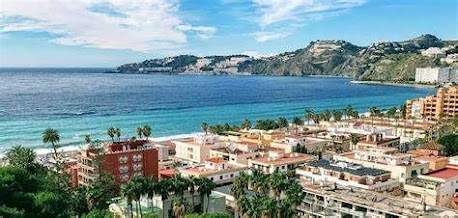Almuñécar is a coastal town in Granada, Spain, with a rich history and a sub-tropical climate that attracts tourists and expats.
========================================================================(in the province of Granada) Almuñécar, a seaport town of Spain, is about 33 miles south of the town of that name. It is a place of Moorish origin, and is tolerably well built. It is a Spanish city and municipality located in the southwestern part of the comarca of the Costa Granadina, in the province of Granada. It is located on the shores of the Mediterranean sea and borders the Granadin municipalities of Otívar, Jete, Ítrabo and Salobreña, and with the Malagueño municipality of Nerja. The Verde river runs through its territory. The municipality of sexitano includes the population centers of Almuñécar (the municipal capital), La Herradura, Velilla-Taramay, Torrecuevas, Río Seco, El Rescate, and El Cerval. Since 1975, Almuñécar has become one of the most important tourist towns in Granada province and on the Costa Granadina; it has good transport connections and a football (soccer) stadium.
+ Almuñécar began as a Phoenician colony named Sexi, and even today, some of its inhabitants still call themselves Sexitanos. Under the Moors, Almuñécar blossomed as the fishing town of al-Munakkab or Ḥiṣn-al-Munakkab.
+ The Romans came to southern Spain at the time of the Second Punic War between Rome and Carthage in 218 BCE as part of their campaign to subdue the Phoenician settlements along the coast.
+ With the decline of the Western Roman Empire in the 5th century, Germanic peoples, including the Visigoths, crossed the Pyrenees mountain range into the Iberian peninsula. By 456 the Visigoths emerged as the dominant power, and expanded their territory onto the southwestern Mediterranean coast. However, Hispania remained relatively Romanized under their rule. The Visigoths adopted Roman culture and language, and maintained many of the old Roman institutions. The Catholic bishops were the rivals of Visigothic power and culture until the end of the 6th and beginning of the 7th century (the period of transition from Arianism to Catholicism in the Visigothic kingdom).
+ Following the restoration of Christian rule, new architectural statements were made The castle was again extensively rebuilt and placed under the patronage of San Miguel. It was rebuilt and heavily fortified by the Christian King Charles III and last defended (by the French) in the Napoleonic Wars. acting in collaboration with Spanish partisans from Nerja on 27 May 1812. They caused the French garrison to flee and then tried to render the castle unusable but with little success (due to the gunpowder being damp). However, the Castle was finished as a military stronghold and following a cholera outbreak in 1830 the castle became the town cemetery, from which use it was cleared in 1986 to permit the restoration which is still in progress.
(The town's economy benefited from increased national and international tourism since the 1970s as well as neighbor Motril.)





No comments:
Post a Comment